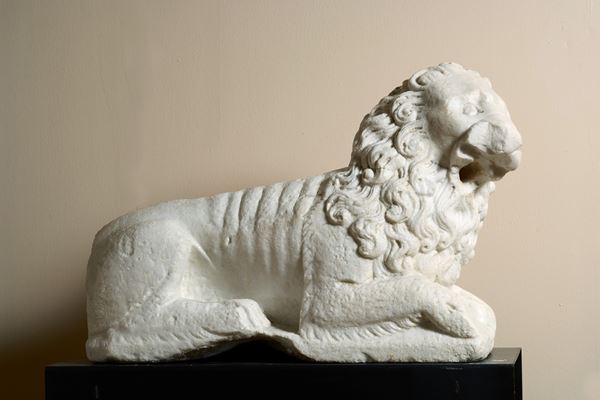35
Tino di Camaino (Siena - Napoli)Workshop of
Marble lion stylophore, first half of the 14th century
Height x width x depth: 55 x 77 x 35 cm.
The work of work is made of Carrara marble, an expensive material that was chosen for its pliability and luster in celebratory and commemorative statuary in use especially inside public houses of worship.
The figure of the lion embodies the cardinal virtue of Justice and was used in Christian iconography as a symbol of the saving power of Christ and his Resurrection.The trapezoidal base, the cut buttocks to allow it to lean directly against the wall, and the crouching pose on the ground all indicate that the work was originally a support element, similar to the lion-columns of the Angevin tomb of Charles of Calabria in Santa Chiara in Naples. The work, however, instead of a pilaster, has a wide groove along its back, which was almost certainly made in modern times and was intended to be used for the water flow. Confirming the contact with water is the right front paw of which only the flattened outline remains. These changes were probably made in the 18th century, as recalled by the inscription on the right side of the lion's face: ''1794.''
Item condition grading: **** good.
The figure of the lion embodies the cardinal virtue of Justice and was used in Christian iconography as a symbol of the saving power of Christ and his Resurrection.The trapezoidal base, the cut buttocks to allow it to lean directly against the wall, and the crouching pose on the ground all indicate that the work was originally a support element, similar to the lion-columns of the Angevin tomb of Charles of Calabria in Santa Chiara in Naples. The work, however, instead of a pilaster, has a wide groove along its back, which was almost certainly made in modern times and was intended to be used for the water flow. Confirming the contact with water is the right front paw of which only the flattened outline remains. These changes were probably made in the 18th century, as recalled by the inscription on the right side of the lion's face: ''1794.''
It is possible to compare the lion with high ones in Angevin Naples, such as: the lions adorning the tomb of Catherine of Austria (first wife of Charles of Calabria) in San Lorenzo Maggiore; the lions on either side of the main portal of the cathedral; in the convent church of Santa Chiara, where two lions of four that supported the pulpit survive; and the lions found in the tombs of Charles of Calabria and his second wife Mary of Valois erected beautiful church of Santa Chiara.
Item condition grading: **** good.
This lot is accompanied by expertise drawn up by Prof. Alessandro Delpriori, Dr. Luca Mor, Art Historian.
Accompanied by Cultural Heritage export licence.
€ 50.000,00 / 70.000,00
Estimate
€ 42.000,00
Starting price
Live auction 277
Corals, Ivories and Silver: masterpieces from important collections - Russian Icons
Palazzo Caetani Lovatelli, thu 30 November 2023
SINGLE SESSION 30/11/2023 Hours 15:00






